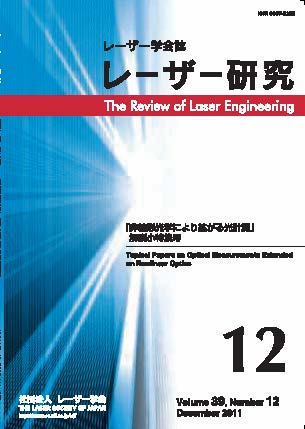All issues

Volume 47, Issue 11
Special Issue on Robot-Photonics, Robots Which Evolve with Photonics
Displaying 1-7 of 7 articles from this issue
- |<
- <
- 1
- >
- >|
Special Issue on Robot-Photonics, Robots Which Evolve with Photonics
Special Issue
Laser Review
-
Kensuke MURAI, Naohiro SHIMAJI2019Volume 47Issue 11 Pages 617-
Published: 2019
Released on J-STAGE: August 16, 2021
JOURNAL FREE ACCESSAs the 21st century would be the century for robotics and photonics, it is the time that we should discuss “robot-photonics” which means a fusion between robotics and photonics for future robot systems. As photonics is essential to recent robot systems, we hope that various cyber physical systems will play important roles in Society 5.0. In 2018, a technical committee concerning robot-photonics had started in the Laser Society of Japan (LSJ). In this special issue, robotic research reports from several fields are presented in order to describe how the robot evolves with photonics.View full abstractDownload PDF (336K) -
Takashi TSUBOUCHI2019Volume 47Issue 11 Pages 619-
Published: 2019
Released on J-STAGE: August 16, 2021
JOURNAL FREE ACCESSIn the field of mobile robotics, there are three major topics: localization, mapping and SLAM. For these topics, obtaining shapes of the objects in the environment is crucial. Typical sensor is LiDAR to obtain the shapes, though other sensors like RGBD camera or stereo vision is also utilized. The present author describes principles of localization, mapping and SLAM and how the sensor behaves for these purposes. He also presents intrinsic characteristics of LiDAR that causes false measurement when there is a gap between objects in depth.View full abstractDownload PDF (1187K) -
Yasuyoshi YOKOKOHJI , Yuichi TAZAKI2019Volume 47Issue 11 Pages 624-
Published: 2019
Released on J-STAGE: August 16, 2021
JOURNAL FREE ACCESSThis paper first introduces some examples where photonics technology such as LiDAR (Light Detection and Ranging) is used to construct a 2D/3D environment map of disaster sites in various disaster response robots. A big problem with LiDAR is that it requires very large computational resources to process a huge amount of point cloud data. Therefore, in the latter half of this paper, we introduce some attempts of our research group to efficiently extract useful information from a huge amount of point cloud data.View full abstractDownload PDF (2669K) -
Yusuke TAMURA2019Volume 47Issue 11 Pages 630-
Published: 2019
Released on J-STAGE: August 16, 2021
JOURNAL FREE ACCESSIn the decommissioning work of Fukushima Daiichi Nuclear Power Plant, various work has been done by remote control robots in order to reduce the risk of radiation exposure to human workers. Remote control robots will be utilized also in the future decommissioning processes such as fuel debris retrieval. This paper first outlines the photonics technologies used with robots in the past decommissioning operations. After that, the paper shows photonics technologies expected from four viewpoints, such as teleoperation interface, situation understanding inside primary containment vessels, decontamination, and cutting of fuel debris, considered to be particularly important in future decommissioning work using remote control robots.View full abstractDownload PDF (389K) -
NIIMI Hirofumi2019Volume 47Issue 11 Pages 634-
Published: 2019
Released on J-STAGE: August 16, 2021
JOURNAL FREE ACCESSRobot photonics education was conducted using Arduino. It is an educational program to learn the basics of microcomputer input/output. The task was to create a robot that responds to the sensor and moves forward and backward. By shaking the blinking LED, we can understand the microcomputer output deeply.View full abstractDownload PDF (1691K) -
Shoichi MAEYAMA2019Volume 47Issue 11 Pages 639-
Published: 2019
Released on J-STAGE: August 16, 2021
JOURNAL FREE ACCESSThis paper describes environmental sensing for a cleaning robot of a fattening piggery. Its environmental conditions include a long, narrow corridor, various types of fences, and a light mist for cleaning. We focus on the development of a fence recognition system using a SOKUIKI sensor (LiDAR) and discuss our experimental results from a real fattening piggery.View full abstractDownload PDF (698K)
Regular Paper
Laser Original
-
Seyed Ali REZVANI, Yutaka NOMURA, Kazuhiko OGAWA, Takao FUJI2019Volume 47Issue 11 Pages 644-
Published: 2019
Released on J-STAGE: August 16, 2021
JOURNAL FREE ACCESSWe present supercontinuum generation (SCG) in a bulk medium and polarization-maintaining ZrF4-BaF2- LaF3-AlF3-NaF fiber (PM-ZBLAN) with 2 μm femtosecond pulses from a regenerative amplifier solely based on Tm:YAP. The amplifier is capable of generating approximately 360 fs, millijoule pulses at 1 kHz repetition rate. The repetition rate of the amplifier system can easily be changed by the Pockels cell up to 10 kHz. Focusing 15 μJ of the amplified signal under 10 kHz operation can generate supercontinuum (SC) in bulk while 0.5 μJ pulse energy of the output is enough to achieve SC that spreads from visible to mid-infrared in a 50 cm long PM-ZBLAN fiber. The mid-infrared part of each SC is characterized using sum-frequency generation cross-correlation frequency resolved optical gating (SFG-XFROG).View full abstractDownload PDF (709K)
- |<
- <
- 1
- >
- >|